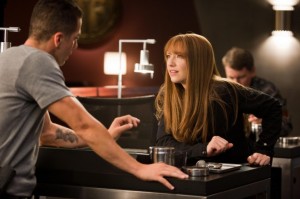
Anna Torv portrays “Fauxlivia,” an version of the main character from the alternate universe that “Fringe” has explored this season.
Beware of spoilers for all seasons of “Fringe.”
J.J. Abrams has something of a knack for casting female leads. Jennifer Garner, for example, earned her breakout role in 2001 as an actress when she was cast as Sydney Bristow on “Alias.” And Evangeline Lilly was an unknown Canadian before “Lost.” Now, you can debate whether or not her acting improved over six seasons, but there is no doubt that she will always be recognized as Kate Austen — the center of the “Lost” love triangles.
The same thing can not be said of Australian actress Anna Torv. She landed the lead role as Agent Olivia Dunham in 2008 for Abrams’ latest Bad Robot production, “Fringe.” Throughout the first season, I tuned in week after week to find interesting, and at times gross, science fiction stories. However, I constantly ended the hour by turning to my dad and saying, “What is with Anna Torv? She just can’t act.”
Two years and two moderately successful seasons later, I can finally see what Abrams must have known Torv was capable of all along. While she once delivered emotionless, straight and downright boring performances, season three has displayed Torv’s acting as up to par with her co-stars John Noble, Joshua Jackson and Lance Reddick.
The shift in acting came around the same time that “Fringe” jumped to a first priority on my selective DVR list, even in the competitive Thursday night time slot. At about the same time, Dunham, Peter and Walter crossed over into the alternate universe.
This is where the story got simultaneously confusing and ingenious very, very fast. Alternate or parallel universes are not something new to the science fiction genre. But a universe as thorough and well done as the “Fringe” alternate world is hard to come across. I can only imagine that the staff sits around the writers’ room for hours having the time of their lives coming up with the minute details of the “Fringe” alternate universe.
At first glance, both worlds appeared very similar, with replicas of places and characters. Large, noticeable differences quickly became apparent as the very real World Trade Center stood in the spot that is now empty. Advertisements for daily trips to the moon and “show-me” ID cards were splattered across cities. “Green Lantern” comics turned into the “Red Lantern.” Ballpoint pens had become so rare that if you asked a random person in the street for one, they would not have a clue what you were talking about. A map of the United States depicted very different territories that certainly did not make up the 50 states. Last time I checked there was only one Texas, not North Texas and South Texas.
If you didn’t happen to catch all the subtleties hidden throughout the various episodes, I can’t blame you. This is the sort of thing targeted at the obsessive viewer — the one that will rewind a scene three times just to make sure they catch everything. The details are for people who will go online later to find high-definition images of those easter eggs. They are for the former “Losties” — for people like me.
More important than the behind-the-curtain differences in the alternate universe are the very apparent discrepancies, specifically the intensified fringe events and the replicated characters that look just like our main characters but are actually quite different.
The map of alternate US depicts territories that have been quarantined into frozen bronze bubbles that cannot be penetrated, freezing everything and everyone inside. All of this was caused by Walter’s invasion into the alternate universe in order to save Peter.
Showing us the alternate universe and the ways the world has been affected by Walter’s decision, forces us to ask ourselves if what he did was right. The butterfly effect comes into play with one choice changing the course of history for an entire universe. Years later, Walter finds himself in the middle of a war that he may have essentially started.
Four episodes into season three, Walter hasn’t yet realized that an imposter has infiltrated his team for the sake of this impending war. “Fauxlivia,” a name the fans of the show made up, looks and acts like Olivia, but she certainly is not her.
This is precisely what has made this season enormously fun. Every episode in the “real” world comes with an extra edge, wondering whether or not “Fauxlivia” will continue to fool Peter and Walter. Watching Torv go back and forth between the two Olivia personalities is both entertaining and bewildering. It’s hard to believe that she is the same actress from season one.
“Fringe” returns from a two-week break on Nov. 4. When it returns, you can be sure I will be watching, scanning the scenes for any sign of the Observer.
“Fringe” airs on Thursdays at 9 p.m. on Fox.
Rosenberg is a member of the class of 2012.




